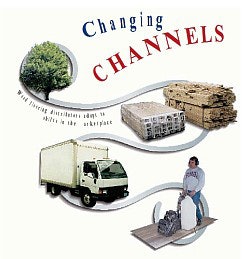

"You better start swimming or you'll sink like a stone, for the times they are a-changing."
— Bob Dylan, The Times They Are A-Changing
If Dylan thought times were changing when he wrote that song in the 1960s, he should see the wood flooring industry today. For the first 80 years or so of this century, wood flooring remained little more than a cottage industry —often a very successful one, but one characterized at all levels by a lot of relatively small, usually family-owned businesses. If you were trying to find an expression to sum up the industry during that time, "down-home" would serve pretty well.
But in the last couple of decades — and especially in the last five years — wood flooring has, in a manner of speaking, gone uptown. Major national and multinational corporations have cast appraising eyes on the success of the industry and decided there is serious money to be made. The result has been a period of acquisition and consolidation, especially at the manufacturing level. Similarly, some of the "big box" home centers have also gotten more involved in wood flooring — selling not only to the DIY market, but also to wood flooring contractors.
In the middle of all this change are the wood flooring distributors, who sometimes find themselves beset by changing alliances with their manufacturer vendors and by shifting loyalties among their contractor customers. As always, the successful distributors will be those who most accurately sense those shifts and adjust accordingly.
Wood flooring distributors are not alone in addressing the challenge. In Facing the Forces of Change, a recently published study by Arthur Anderson LLP, commissioned by the National Association of Wholesaler-Distributors, 650 distributor and supplier participants predicted that one out of four distributors will not survive the next five years.
"We're seeing these changes in distribution occur in all industries, not just in wood flooring or floor coverings," says Jeff Hamar, president of Galleher Hardwood in Santa Fe Springs, Calif., and president of the National Association of Floor Covering Distributors. "You see it in industries as diverse as food service and plumbing."
Where people often differ is in how they see the pace of change proceeding.
"I think a lot of people right now overestimate the amount of change that's going to take place in the next two years," says Hamar, "but they underestimate what's going to happen over the next 10 years."
In other words, says Hamar, explosive change may not occur in the near future, but deep and significant change will occur over the long haul.
The most significant change is likely to be in the number of distributors operating in any industry. Like many, Hamar expects to see a gradual decrease in the number of distributors, largely as a result of mergers and acquisitions, but also as a few fall by the wayside.
Most endangered, Hamar believes, are medium-sized distributors who try to compete head-on with larger companies, but who lack the resources to do so effectively. That leaves a scenario in which an industry is likely to be dominated by a few large distributors, with many smaller distributors operating in niche markets. In fact, much of the growth opportunity may exist for small distributors who find a product or service niche that they can market to better than the large distributors.
"If you look at trends," says Hamar, "the number of wholesaler-distributors actually increased in 1998, and almost all of that growth occurred among distributors with one to nine employees. I think that will continue to be an area of growth, but overall I still think the trend is going to be toward fewer distributors."
FACING CHANGE AND CHALLENGE
Ask a group of wood flooring distributors from all around North America about the changes and challenges they face and you'll get a fairly consistent litany of concerns:
• Increased competition: In many areas, long-standing distributors are finding new distribution companies coming into their market. In part, that's a result of the success of the wood flooring industry: New companies see opportunity in the increased volume of products being sold.
"We're seeing more competition from new wholesale distributors and those who call themselves one-stop distributors," says Dick Hagerman of Lon Musolf Distributing in Vadnais Heights, Minn. "A lot of people want to get on the bandwagon."
Manufacturers, of course, have also seen growth opportunities, so there are more lines of wood flooring, finishes, adhesives, abrasives and equipment in the marketplace.
"I think we'll see that the weakened Asian economy will bring in even more low-cost imports, just as the ceramic tile industry has seen," says David Bennett of Bennett Supply Co. in Cheswick, Pa.
The result: Existing distributors can't carry all the competing lines of products, so new distributors have emerged to pick up those lines.
"There are more good product lines to carry today than there were in the past, so you're seeing more distributors carrying wood flooring," says John Pankratz Jr. of Kelly-Goodwin Co. in Tukwila, Wash.
The result of such increased competition, says Tom Gormley, vice president of the flooring division at Goodfellow Inc. in Delson, Quebec, "is that profit margins can be driven down."
Lower profit margins for distributors might not seem to be a concern for contractors or manufacturers, but a financially healthy distribution link is the key to a smoothly functioning wood flooring industry.
"Manufacturers are real concerned with the health of the distribution network, because that's our link with dealers and installers," says John Stern, president of Kentucky Wood Floors in Louisville, Ky. "Distributors multiply our efforts, because there's no way we can reach all those potential customers by ourselves."
More distributors in a marketplace might also mean that some of those distributors are new to the wood flooring industry and somewhat lacking in knowledge and expertise.
"The entry into the wood flooring market by distributors and retailers who lack knowledge about wood flooring products means we're seeing more misinformation and poor quality work,"says Fagan Cox, president of John Cox Lumber Co. in Houston. "As a result, we're seeing more complaints and more consumers dissatisfied with their wood floors."
• Consolidation among manufacturers: At the same time that new manufacturers are entering the industry, some of the older ones have begun consolidating. The acquisitions of Hartco Flooring, Premier Wood Floors and Robbins Hardwood Flooring by Triangle Pacific— and the subsequent acquisition of Triangle Pacific by Armstrong World Industries — are just the most obvious examples. Harris-Tarkett and The Burruss Company have also been active in acquiring other wood flooring companies in recent years.
Some distributors worry that if that trend continues, long-time distributors of a product line will be cut out of the supply loop for that product. If Distributor A, for example, carries Brand X and Brand X is acquired by Brand Y, it's possible that Distributor A's cross-town rival, a Brand Y distributor, will get both lines, leaving Distributor A scrambling for a new line to carry.
"We have a concern about how supplier consolidation may affect us in the future," says James Wadsworth of NGF Distributors in Alpharetta, Ga. "It's not affecting us today, but we are making plans to ensure that consolidation will not be catastrophic for us in the future.
• Controlled profit margins: Some distributors say they've encountered an increased tendency on the part of manufacturers to dictate pricing and profit margins. Distributors say they find that trend disturbing because it intrudes on their ability to manage the flow of products to the end users, and because narrower profit margins adversely affect their ability to provide quality service.
"We're seeing more suppliers dictating to distribution and forcing distribution to be more dictatorial with retailers and contractors," says Wadsworth. "Neither of those is customer-friendly."
"More and more vendors are telling distributors what they can charge for their products in the marketplace," says Pankratz. "The problem is, most vendors don't have a good idea as to what total services their distributors offer."
In Facing the Forces of Change, 84 percent of wholesaler-distributors agreed with the notion that distributors' functions are "not understood by manufacturers," and 90 percent believe that "manufacturers feel that distributors' gross margins are more than adequate."
Rick Prohammer, an assistant director with Arthur Anderson and one of the principal authors of Forces of Change, says distributors' views about how manufacturers see them is, "We don't know what it is you do, but we feel you're more than well-compensated for it."
Somewhat surprisingly, manufacturers participating in the study tended to agree. Seventy-four percent agreed that manufacturers didn't understand distributors' functions, and 79 percent said that manufacturers believe distributors' profit margins are "more than adequate."
• Manufacturer-direct sales: This is not a new problem, of course, but some distributors say the increasing number of manufacturers has meant that some feel they have to sell direct to get their products to the marketplace.
"We're seeing a lot of new manufacturers and importers coming in," says Hagerman of Lon Musolf Distributing, "and when they can't find a distributor to carry their products in your market, they'll try selling to your customers."
• Competition from "big box" home centers: The mega-retailers in the home center industry mainly target do-it-yourselfers, but some distributors have worried that they are also marketing their products to wood flooring contractors, in effect becoming distributors.
"The box stores are controlling greater market share, bypassing distribution," says Gormley.
Fortunately, the concept doesn't seem to have become popular with contractors, most of whom see home centers as direct competition. If a home center is trying to sell products direct to the consumer — the contractor's potential customer — why would the contractor patronize that competitor?
That's borne out in the results of a recent Hardwood Floors survey of woodflooring retailers and contractors, in which they were asked to list all their purchasing sources for wood flooring and related products. Among contractors, 88 percent said they bought products from specialty wood flooring distributors and 43 percent said they bought some products direct from the manufacturer. Only 20 percent said they purchased products from a general floor-covering distributor or from a home center. Among wood flooring retailers, 78 percent said they bought wood-flooring products from general floor-covering distributors and 60 percent said they bought from specialty wood-flooring distributors. Twenty-six percent said they bought some products direct, but none bought products from home centers.
• Managing inventory and keeping credit under control: These factors represent two traditional roles distributors have performed for contractors— maintaining a ready supply of products close to the locale of demand, and carrying credit for contractors. Both are becoming greater challenges, say distributors.
"It's getting harder to get paid on time, so credit management has become more of a full-time position at wood flooring distributors — thus more overhead," says Pankratz. "The key is to extend credit only to those who have shown they will pay on time. Others pay cash, and with the real problem customers, we're better off sending them to our competitors."
Distributors need to maintain enough inventory to be able to service their contractor customers, but inventory also represents tied-up capital — more overhead. So, distributors face the delicate balancing act of stocking enough products to assure customers of on time delivery, but not so much inventory that money is tied up unnecessarily.
• Finding and keeping good salespeople: This issue was cited by virtually every distributor contacted — suggesting perhaps that distributors recognize that customer service is going to be the key to their success, and that customer service begins with informed salespeople.
"Finding good salespeople will continue to be a major challenge," says David Williams of Horizon Forest Products in Raleigh, N.C. "We should be aware of the people we come into contact with every day. You next employee might be a 'hello' away."
• Building partnerships: Participants in the Forces of Change study listed developing strategic alliances as one of the four key trends reshaping distribution, and distributors in the wood flooring industry tend to agree.
"You must partner with reliable suppliers — ones that will protect and support you," says Fagan Cox of John Cox Lumber.
• Making use of electronic technology: "Distributors are really going to have to embrace change," says Stern, "especially in regard to computers and other electronic technology.
"That was the second of the other key trends noted in the Forces of Change —the growth in electronic commerce. Participants in the study indicated that the impact of electronic commerce has so far been minimal in distribution, but that electronic commerce will shift from a competitive advantage to a competitive requirement within five years.
In wood flooring distribution, electronic commerce might look something like this: A dealer or contractor has access to a distributor's inventory database. Day or night, the customer can check the inventory for availability, place an order and schedule delivery. Invoicing and restocking follow automatically.
A system like that, technology buffs note, would allow distributors to service their customers better, and also streamline the inventory-management process.
Supply chain integration and globalization: These are the other two key trends noted in the Forces of Change report. Integration of the supply chain means that distributors and suppliers will work more closely to eliminate "redundancies" in sales and marketing efforts and inventory management. Participants also noted that, currently, manufacturers are thinking globally while distributors are still operating on a local level.
BUILDING VALUE
The biggest challenge of all, according to several successful distributors, is to find ways to continue to add value to the marketplace. Providing exceptional customer service is the key to adding value, they say — enough to offset any perceived advantages of direct sales and price competition.
"Distributors' traditional reasons for being remain valid today, although manufacturers and others have begun to take on some of these roles," says Gormley of Goodfellow. "However, there are several actions that can be taken by distributors to create value and ensure their survival."
Among those actions, says Gormley: "Maintain good inventories, coupled with rapid delivery, even for small orders. Source products globally to maintain a competitive edge. Use private branding to create your own consumer franchise. Offer training to your clients and help clients develop advertising and promotional strategies. Also, manage small details to drive out unnecessary costs."
Prohammer says the Forces of Change study shows that building value in a marketplace is often a matter of developing "core competencies — a source of sustainable competitive advantage."
That advantage is built by delivering a product or service that the customer values, and that is difficult for competitors to duplicate.
"You need to provide the best service in your marketplace," says Pankratz. "That means providing technical support, delivery service, maintaining adequate inventory and repairing the equipment you sell."
Service is going to mean different things to different customers, but more manufacturers and distributors are seeing product knowledge and expertise as critical issues, especially as more products reach the marketplace. That places a high value on information and on the ability to deliver that information to the customer. Eighty percent of the participants in the the Forces of Change study agreed that they faced a shortage of qualified and knowledgeable personnel, and they expect the amount of money spent on staff training to double in the next five years.
For distributors in the emerging marketplace, it may turn out that what you know is as important as who you know.
"A distributor's value to the dealer or contractor lies not so much in offering the best price or the best delivery, but in providing the best service in terms of expertise," says Stern of Kentucky Wood. "That becomes critically important when you look at the wide range of wood flooring products available today— different species, different patterns, prefinished and unfinished, solid and engineered. I think dealers and contractors are looking to distributors to weed through all the product information and tell them what works in a given situation. They're looking for a comfort zone, where they know they'll be taken care of throughout the purchasing and installation process." .
































